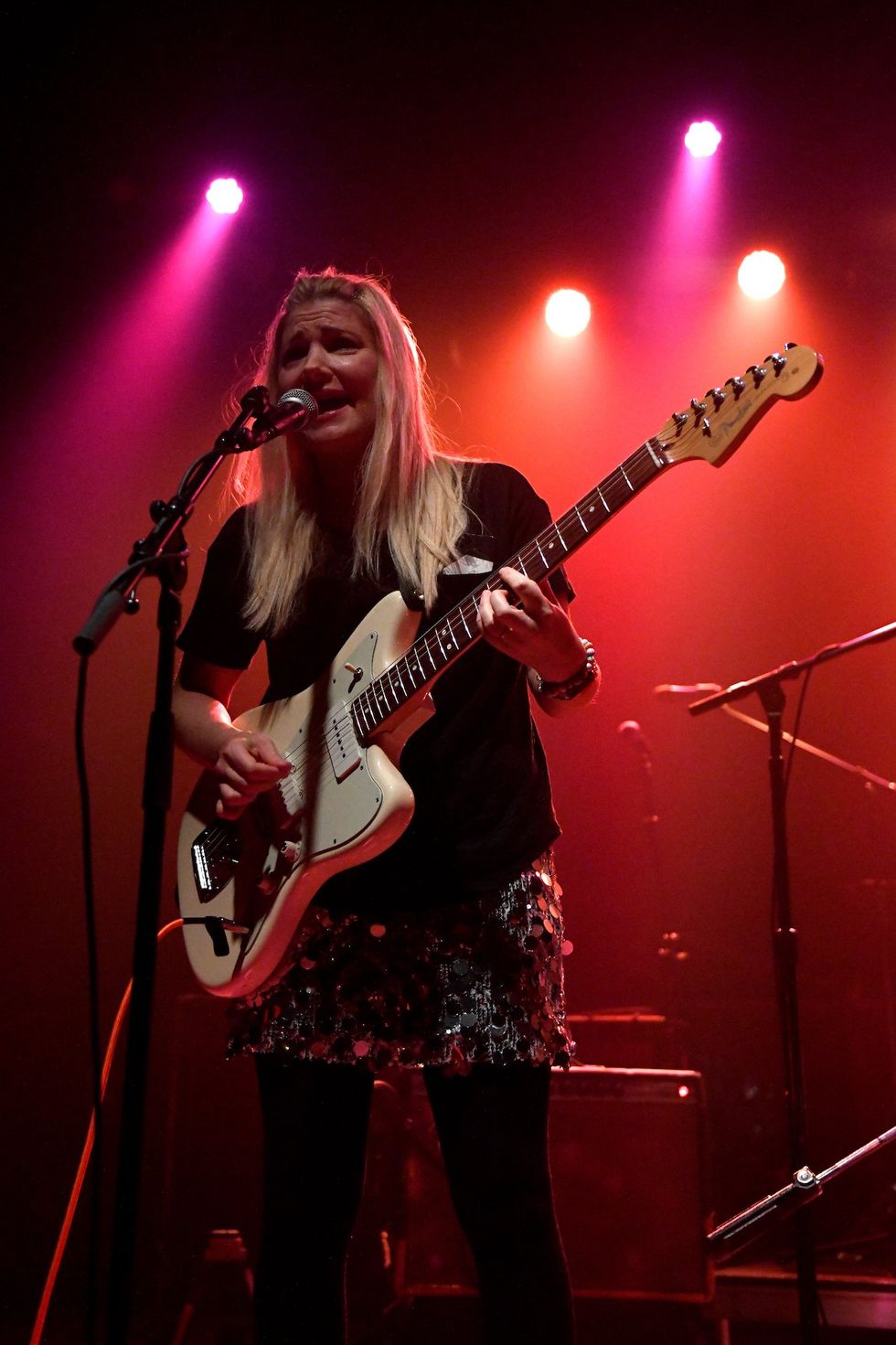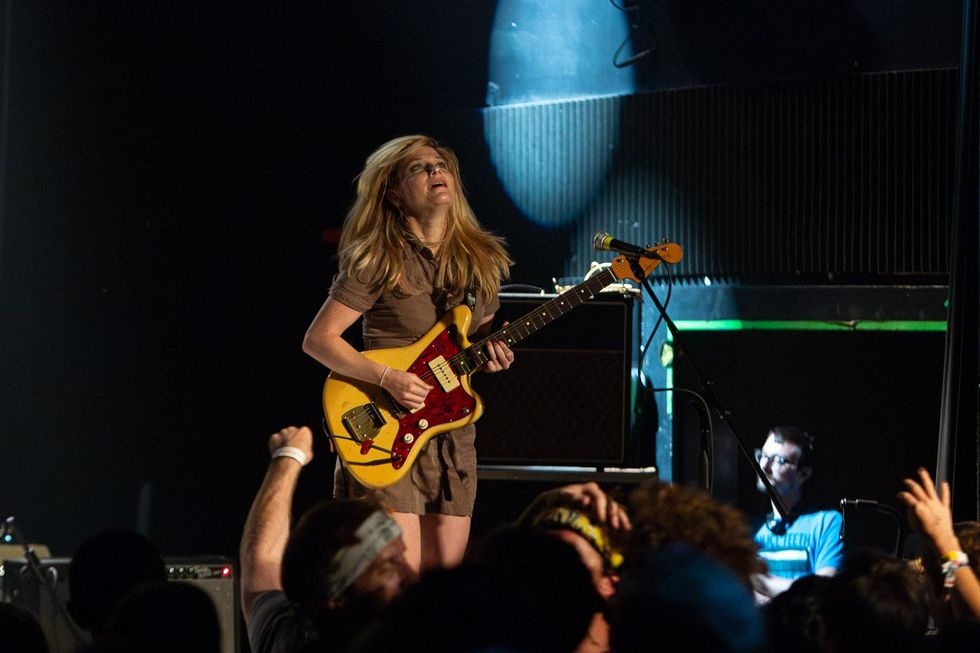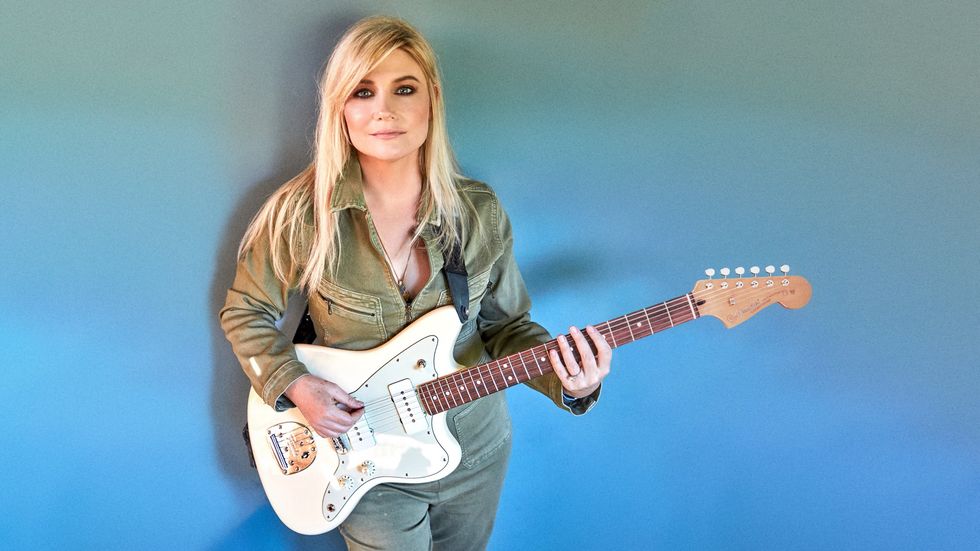For Marnie Stern, it’s all about the riff. “I used to have a sign on my wall that said, ‘The Riff! The Riff! The Riff!’” she says. “Because, for me, when you’re working alone, it’s easy to drift away from the riff.”
Without one, she says, “[the music] would be like a textural thing behind me,” and while that may not be a bad thing, that’s not her vibe. Her influences include the Who and Talking Heads, noise and post-punk bands like U.S. Maple and Erase Errata, and math-rock group Hella, whose sounds inspire her to take a different approach. “I want to remind myself about all the rock songs that I grew up listening to, and the riff is really key on all those songs.”Stern’s new album, The Comeback Kid, is a smorgasbord of blazing gems that stay true to her riff-centric ideals, and cut to the chase with clever and assertive phrasing. In a way, it may even be a nod to the Minutemen, with every song clocking in between two and three minutes, as Stern eschews the standard verse/chorus formula in favor of erratic arrangements that take you on exciting, albeit compact, sonic journeys.
The Comeback Kid is quirky, angular, and unsettling, but delivered with a coy sense of humor. Many of the songs, like the opening track “Plain Speak,” as well as “The Natural” and “Oh Are They,” are built around fast, high-end, multilayered, tapped guitar figures. Then “Forward,” the fifth song on the record, interrupts the brightness for something more sinister, sounding like a strange synthesis of Houses of the Holy-era Zeppelin and Talking Heads, with a touch of flange. There’s also an odd-metered spaghetti Western cover of Ennio Morricone’s “Il Girotondo Della Note,” which gets increasingly eccentric before ending abruptly one minute and 19 seconds in. “At this point, weird time signatures are just baked into me,” Stern elaborates. “A song will almost never be in 4/4, but I am not really trying to make it that way. I just come up with a phrase—I can always tell it’s not in four, but I don’t know exactly what it is.”
“A song will almost never be in 4/4, but I am not really trying to make it that way.”
Stern recorded all of the guitars and vocals at home using Pro Tools, and she finds coming up with vocal parts to be the most difficult. “[It’s] the hardest part for me,” she says. “I am very comfortable putting together interesting guitar parts, and I work really hard on each tiny part. An eight-second part could take all day, developing it and the intricacy of what it is going to be. That’s why I end up layering so many vocal tracks, because it’s just so hard for me to figure out the right melody. That’s also part of why I yell so much; my screaming style is because melody is my biggest challenge.”

The Comeback Kid marks Marnie Stern’s return to her solo career since her last album in 2013, and features only guitars and drums.
The path of least resistance in producing the guitar parts, she explains, was to record all of them direct. “I live in Manhattan and the neighbors would go bonkers,” she says about the possibility of cranking an amp in her cramped New York apartment. Stern’s pedal of choice is the Tech 21 SansAmp GT-2 tube amplifier emulator. (She runs that pedal, along with a Boss Digital Delay, through a Fender Deluxe Reverb when performing live.) Overall, her approach is decidedly barebones. She’s a loyal Fender Jazzmaster user as well, though she does have two of those. “I just love the Jazzmaster,” she says. “I have an older one, and then the past bunch of years I’ve been playing this American Pro Series that Fender came out with a couple of years ago. But that’s basically it.” That simplicity also applies to the album’s instrumentation. Aside from vocals, The Comeback Kid features nothing but guitars and drums, the latter of which was added later.
“I thought all those other styles were going to be sunk in there, but I guess because they weren’t mine, it didn’t stick.”
Thanks to the enlisting of Arcade Fire’s drummer Jeremy Gara, the drum parts for the album were a piece of cake. Stern sent Gara the tracks and trusted him to do the rest. “I mean, Jeremy’s an amazing drummer,” she says. “Arcade Fire is an amazing band. He knows what he’s doing. I didn’t give him anything. Not a thing.” For having gotten into the music without any direction, Gara’s drumming fits in perfectly with Stern’s frenetic, unflinchingly exuberant energy.
Marnie Stern's Gear

In her songwriting, Stern leans into odd time signatures mixed with layered vocals and tapping, and of course, the riff.
Photo by Frank White
Guitars
- ’80s Fender Jazzmaster
- Fender American Professional Series Jazzmaster
Amps
- Fender Deluxe Reverb
Effects
- Tech 21 SansAmp GT2
- Boss DD-8 Digital Delay
Strings & Picks
- D’Addario .010s
- Fender Medium picks
Once it had all coalesced, The Comeback Kid became Stern’s first album after she’d taken a long break from her solo career, a period which included an eight-year stint as the guitarist in the 8G Band, the Fred Armisen-led house band for Late Night with Seth Meyers. The 8G Band is unusual in that, instead of a cast of studio heavyweights, Stern’s co-conspirators included musicians pulled from the indie-rock world, such as Seth Jabour and Syd Butler from the art-punk band Les Savy Fav, Eli Janney from Girls Against Boys, and Armisen, who played with the Chicago-area punk band Trenchmouth.
“In the beginning, we would have a different drummer each week,” Stern says. “The drummer from Primus would be on and we’d learn a Primus song, or the drummer from the Pixies would be on so we’d learn a Pixies song, or Chad Smith from the Red Hot Chili Peppers was on so we learned a Chili Peppers song, and on and on and on. It was a lot of different drummers and styles, and I think that helped a lot—jumping into a different band and learning the song. It was a very quick turnaround. Plus, we wrote eight songs a day. We could have notes on stage, and we had in-ear monitors to hear a playback of the song before the commercial break. I had just been in my one world [before joining], so it was a really great experience.”
“If a part is interesting, I’ll put it in, even if it’s not commercially going to further my career. I just like what I like.”

Stern’s main axe is a Fender Jazzmaster, which she’s seen playing here in a performance back in 2013.
Today, Stern reflects on her time with the 8G Band with a mixed perspective. “It was great to do it for those eight years, and then it was great not to. It’s just that that whole thing is about [Seth Meyers]. It’s great to do that world. But it’s also nice to do something for yourself a little bit.”
Despite taking a long hiatus from her solo career—not writing new material, recording, touring, or even playing her old songs—and then coming back chock full of new styles, situations, and collaborators, Stern sounds right at home. The Comeback Kid comes across as if she simply picked up where she left off.
“I guess other people learn properly, but that’s just how I’ve always done it.”
“For those eight years, I barely played anything of my own,” Stern shares, “and then when I sat down to write, I couldn’t believe how quickly it just came back. I thought all those other styles were going to be sunk in there, but I guess because they weren’t mine, it didn’t stick.” Although, all that time on TV did affect her attitude. “I grew a bit more technically, in terms of how to do certain things, but I came back to, ‘I don’t give a fuck.’ If a part is interesting, I’ll put it in, even if it’s not commercially going to further my career. I just like what I like.”

Before recording The Comeback Kid, Stern spent eight years playing with the 8G Band on Late Night with Seth Meyers.
Part of what Stern came back to is her idiosyncratic approach to two-handed tapping. “I need to keep the pick for the next part,” she says, “so I hold it in my hand and use my middle finger at the same time to tap. With my left hand, a lot of the time I’ll use my pointer and my ring finger, but not my pinky. Isn’t that strange how you just do something? I guess other people learn properly, but that’s just how I’ve always done it.”
Tapping is all over The Comeback Kid, as heard on the anthemic-sounding “Working Memory,” which also includes somewhat contrapuntal figures from the different layers of guitar (plus dissonant stabs and a provocative solo, too). It’s also on the almost manic “Nested,” that seems to mellow near the end where she employs a more textural usage of the technique. But, tapping isn’t the only thing she does. She’s also got a mean picking hand, which you can hear in action especially when she’s leaning into upper-register tremolo parts on the album’s second single, “Believing Is Seeing.”
Tone inspires her, too, although once you start talking about tapping and tone, somehow she finds a way to bring that back to the riff. “Of course tone inspires me,” she says, “and for tapping, distortion inspires me. But I am really into focusing on the riff and trying to get that as full as possible.”
YouTube It
Stern’s only taken to the stage again recently, but this video from 2013 shows her exercising her spectacular chops and knack for bright, energetic, and uplifting fronting and songwriting.






![Rig Rundown: AFI [2025]](https://www.premierguitar.com/media-library/youtube.jpg?id=62064741&width=1245&height=700&quality=70&coordinates=0%2C0%2C0%2C0)












 Shop Scott's Rig
Shop Scott's Rig













 Zach loves his Sovtek Mig 60 head, which he plays through a cab he built himself at a pipe-organ shop in Denver. Every glue joint is lined with thin leather for maximum air tightness, and it’s stocked with Celestion G12M Greenback speakers.
Zach loves his Sovtek Mig 60 head, which he plays through a cab he built himself at a pipe-organ shop in Denver. Every glue joint is lined with thin leather for maximum air tightness, and it’s stocked with Celestion G12M Greenback speakers.












![Devon Eisenbarger [Katy Perry] Rig Rundown](https://www.premierguitar.com/media-library/youtube.jpg?id=61774583&width=1245&height=700&quality=70&coordinates=0%2C0%2C0%2C0)








 Luis Munoz makes the catch.
Luis Munoz makes the catch.


